The 8 Best Coolers of 2023, Tested and Reviewed
Dotdash Meredith and Yahoo Inc. may earn commission or revenue on some items through the links below.
After testing 48 models, we found the most portable, durable picks that will keep your drinks ice cold.
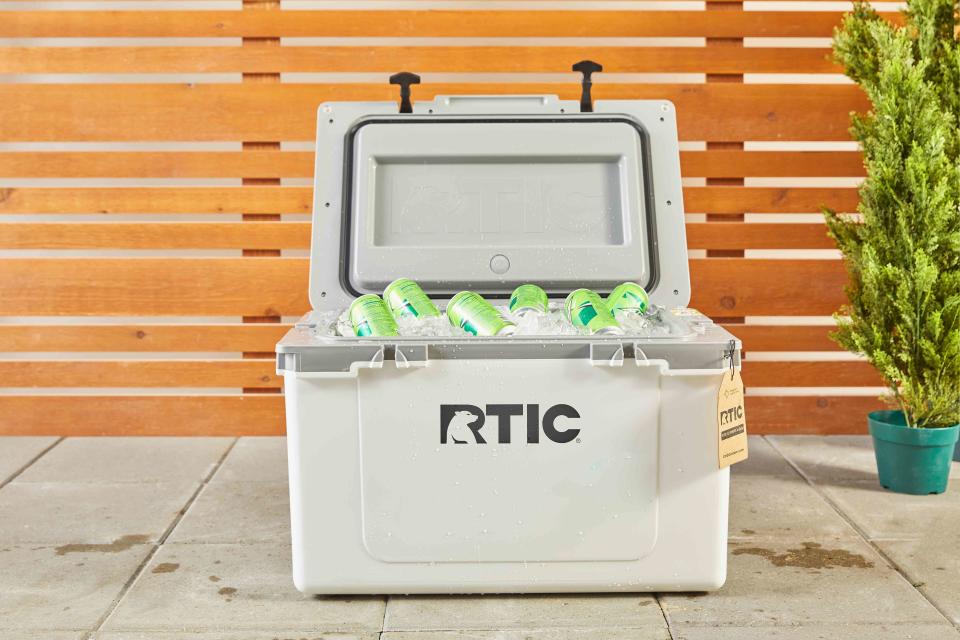
Real Simple / Henry Wortock
Fact checked by Shereen Jegtvig
The cooler market is crowded, and you might think you need to pay top dollar in order to get a high-quality product. But whether or not this is true ultimately comes down to your needs—are you planning to use the cooler for an extended camping trip or an afternoon picnic at the beach?
To find the best coolers for every situation, we put 48 models through rigorous testing (including coolers with wheels and backpack-style soft coolers). We evaluated each cooler based on its design, capacity, insulation, portability, durability, and overall value. For expert insight, we tapped Bass Pro Shops and Cabela’s merchant Jesse Schulte.
According to Schulte, “size and capacity, weight, and ice retention” are the most important factors to consider when shopping for a cooler. “To determine the size of the cooler you will need, first consider your activity—the practicality of bringing along a larger, heavier cooler or a smaller, more portable one,” says Schulte.
Here are the best coolers for beach days, camping trips, and more.
Best Overall Cooler: RTIC 52-Quart Ultra-Light Cooler

What Stands Out
It’s impressively lightweight and much more cost effective than most coolers of this size.
What Could Be Improved
Its long-term durability and ice retention may not be as good as rotomolded coolers.
Our top pick looks strikingly similar to a Yeti, and its performance was nearly identical: After 24 hours, the internal temperature of the RTIC cooler had only increased by 0.4 degrees Fahrenheit. It’s also versatile—we found the 52-quart capacity to be just right for a weekend road trip, but it could also just as easily work for tailgating or entertaining.
The brand notes that this model is 30 percent lighter than rotomolded coolers of the same capacity, weighing just 21 pounds when empty. But this doesn’t mean it’s not durable: During testing, we noticed it didn’t leak when tipped over and there wasn’t more than a scratch after it was pushed off the table while full. This is likely due to the side plugs on either side of the cooler, which we found prevented spilling and made for an effortless draining process. This lightweight design and long-term ice retention make it well suited for many on-the-go endeavors, particularly if there is a long trek involved.
But what’s especially impressive about this cooler is its price point: The RTIC 52-Quart Ultra-Light Cooler is more than $100 cheaper than similarly sized Yeti coolers. Given that it’s made with an injection molding process, this cooler’s long-term durability and ice retention may fall a little short of rotomolded models—though our testing suggests there may not be as big of a difference as the price would imply. Given its lightweight, sturdy, and spill-free design, we feel this cooler is a great overall pick.
Price at time of publish: $200
Dimensions: 27.25 × 17.25 × 17 inches | Capacity: 52 quarts | Weight: 21 pounds
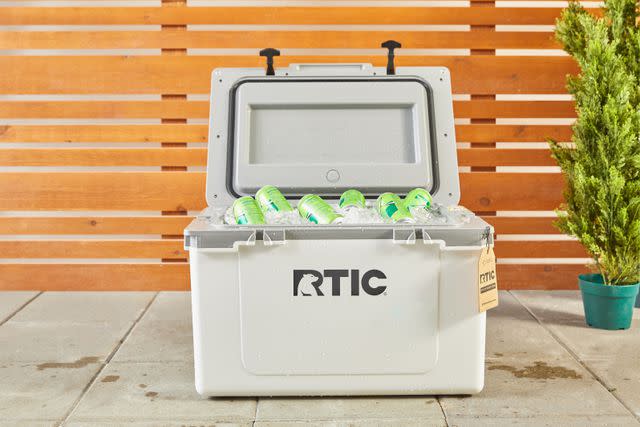
Real Simple / Henry Wortock
Best Budget Cooler: Coleman Chiller 48-Quart Cooler

What Stands Out
It’s a large, budget-friendly option for those seeking short-term use.
What Could Be Improved
It doesn’t have wheels, so you will have to lift it as opposed to dragging it, and it doesn’t have a drain plug.
This medium-capacity cooler from Coleman is one of the best deals out there given its price, quality, and durability. During our testing, about 50 percent of the ice remained frozen after 24 hours, and the temperature only increased by 1.8 degrees Fahrenheit. Based on these results, we think that this cooler is best suited for day trips or backyard gatherings.
In our durability tests, the cooler was very sturdy and easy to sit on, and it didn’t suffer any damage after being pushed off a table while full of ice—although the lid opened, causing the contents to spill out.
Though this cooler may not have all the bells and whistles of more expensive models, such as a drain plug or bottle opener, it does come with cup holders. We also appreciated the classic side handles and the secure, tight-fitting lid. According to the manufacturer, this cooler is tall enough to accommodate a two-liter bottle standing upright. Compared to many of the coolers on our list, this pick is relatively lightweight and easy to lift. For the average person who simply needs a cooler for occasional use over the course of a day, the Coleman Chiller is an excellent value.
Price at time of publish: $40
Dimensions: 15 x 25.5 x 14.2 inches | Capacity: 48 quarts | Weight: 8.1 pounds
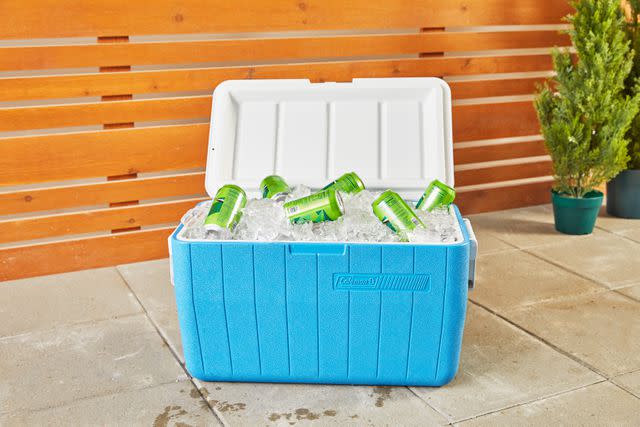
Real Simple / Henry Wortock
Best Splurge Cooler: YETI Tundra 65 Cooler

What Stands Out
It keeps ice frozen for several days, making it suitable for longer trips.
What Could Be Improved
The cooler is pretty heavy and may take up a lot of space in a car.
The Yeti Tundra 65 Hard Cooler is made through a process known as rotomolding, which is when a mold is filled with molten plastic and rotated to achieve an even thickness. The result is a highly durable cooler with excellent ice retention. In our testing, the Tundra lived up to its promises, increasing in temperature by only 0.2 degrees Fahrenheit over 24 hours and not sustaining any more damage than a scratch after being pushed off a table while filled with ice.
During testing, we found that the heavy-duty rubber latches felt secure, and the rope handles were easy to grip. One drawback of rotomolded models is that they often don’t come with built-in bottle or cup holders, as is the case with the Tundra 65—although we found this to make it more comfortable to sit on and use as a tabletop when camping (and the brand notes that it doubles as a casting platform while fishing, too). Like all Yeti products, this cooler is available in several color options.
At 30.3 pounds while empty, this cooler will require two people to lift it, and it will take up a fair amount of space in a vehicle. We think its size and ice retention make it suitable for a family of four to take over the weekend. While most people don’t need to spend this much on a cooler, the Yeti Tundra may be well worth the splurge for outdoor enthusiasts who need a cooler with serious lasting power.
Price at time of publish: $375
Dimensions: 17.3 x 30.8 x 16 inches | Capacity: 65 quarts | Weight: 30.3 pounds
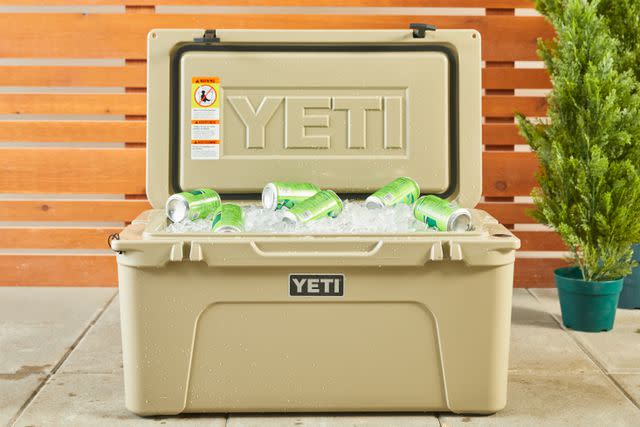
Real Simple / Dera Burreson
Best Wheeled Cooler: XSpec 45-Quart Towable Rotomolded Cooler With Wheels

What Stands Out
It’s highly durable and easy to maneuver.
What Could Be Improved
It’s very heavy.
In our testing, we were impressed with how the Xspec 45-Quart Towable Rotomolded Cooler With Wheels measured up against brands like Yeti and Orca. Constructed with three inches of insulation, this cooler stayed cold enough to keep over 80 percent of the ice frozen after 24 hours.
But where this cooler really stands out is its portability: It has an adjustable tow handle and eight-inch wheels, which glided over both concrete and grass in our testing. It also comes with grab handles if you prefer to use them for carrying this cooler over short distances. We observed that it can get quite heavy to tow when at capacity, although the rolling mechanism certainly makes maneuvering it more feasible for one person.
It’s also no surprise that this rotomolded cooler is a standout for its durability, too. It’s solid to sit on when shut and only suffered some slight scratching during our drop test. We also like that it comes with bottle openers and a drain plug. Overall, this is a well-built and reasonably priced cooler that comes with the added convenience of being able to wheel it when you don’t want to carry a heavy cooler over long distances.
Price at time of publish: $245
Dimensions: 18 x 22 x 21 inches | Capacity: 45 quarts | Weight: 35 pounds
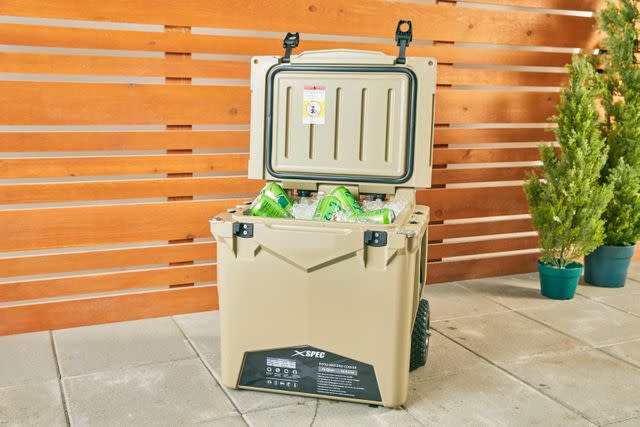
Real Simple / Henry Wortock
Best Soft-Sided Cooler: Engel HD30 Heavy-Duty Soft Sided Cooler Bag

What Stands Out
It has several mechanisms to avoid leakage and keep contents cool.
What Could Be Improved
It can get heavy when stuffed, and the water-tight zipper can be difficult to open.
We found this cooler to be an ideal size, large enough to fit a good amount of beverages but small enough to not take up too much space. In our tests, it fit 60 cans with no ice, and 20 cans when filled with a 2:1 ice to can ratio. We also appreciated the cooler’s insulation, as it dropped only 0.3 degrees Farenheit in temperature after 24 hours. During our testing, about 41 percent of ice remained after 24 hours. A suction option also allows you to vacuum out extra air to keep your beverages cool.
During testing, we were especially impressed by how secure the cooler was. It is crafted with a durable, waterproof material and has an extra secure zipper designed to prevent leakage, in addition to a drainage plug. We found that the interior seemed to be almost welded shut, which successfully ensured the cooler was leak-free and kept contents cool inside. While the water-tight zipper can make the cooler challenging to operate, it does come equipped with lubricant to help it glide more easily.
Due to its large capacity, the cooler can be heavy to hold while walking long distances. Even so, it has a removable shoulder strap, top handles, and side handles for convenience. Portable and leak-free, this cooler is a versatile choice ideal for on-the-go activities.
Price at time of publish: $240
Dimensions: 20.5 x 9.5 x 17 inches | Capacity: 32 quarts | Weight: 5.25 pounds
Best Backpack Cooler: The Get Out Cooler Bag

What Stands Out
This hands-free cooler is soft-sided, stylish, and can easily fit a bottle of wine.
What Could Be Improved
It has subpar ice retention, making it less ideal for long-term use.
Style and function merge in this retro-inspired backpack cooler that is tall enough to fit a bottle of wine (up to six!) for an afternoon at the beach or a picnic in the park. We found it to comfortably hold about 20 cans with no ice and seven cans with a 2:1 ratio of ice to cans. It didn’t compete with the other coolers on our list in terms of ice retention—after two hours, about two-thirds of the ice remained, and after 24 hours, all of the ice had melted. But to be fair, The Get Out only claims that its bag will keep cool for one day.
While we found the backpack straps to be very comfortable, the cooler bag also comes with side handles if you prefer to carry it that way. Although it doesn’t have magnetic closures like Yeti’s soft-sided coolers, we thought the zipper closure was very smooth. During our drop test, no ice came out of the bag and it didn’t scratch at all, either.
Given its ice retention capabilities, we wouldn’t recommend this cooler bag for an overnight trip or even a full day at the beach. Even so, it’s a great, smaller option suitable for an afternoon spent hiking or in the park with friends. Lightweight and stylish, this cooler will keep your hands free at all times.
Price at time of publish: $260
Dimensions: 10 x 17.15 x 16 inches | Capacity: Not disclosed | Weight: Not disclosed
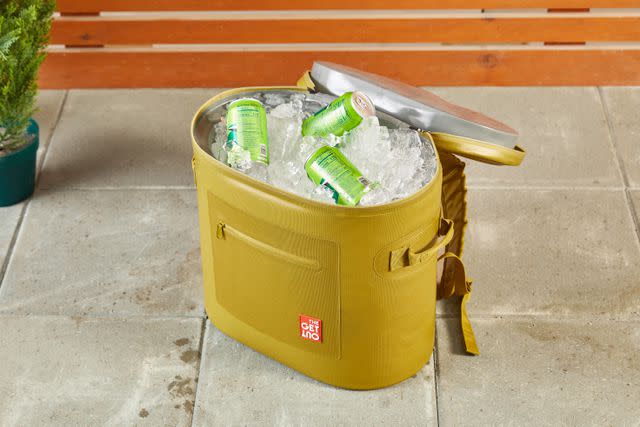
Real Simple / Henry Wortock
Best Large Cooler: Orca 140-Quart Cooler
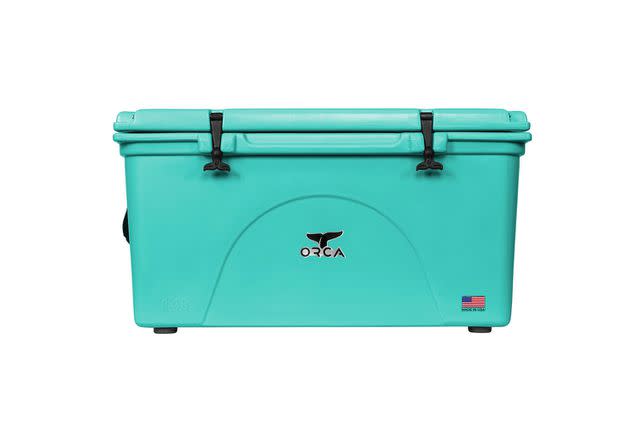
What Stands Out
With its extra large capacity, this cooler works well for heavy-duty use.
What Could Be Improved
It’s the heaviest and most expensive cooler on our list.
If you’re transporting large game meat or hosting the biggest backyard barbecue of the summer, this massive, 140-quart rotomolded cooler will leave you satisfied. The manufacturer notes that it can hold up to 192 cans, but we found it to hold 206 cans without ice and 68 cans with a 2:1 ice to can ratio. In our testing, the cooler’s interior temperature only increased by 0.9 degrees Fahrenheit, and 75 percent of the ice remained frozen after 24 hours.
We found the latches to be a little difficult to use. Even so, the cooler didn’t leak or open when tipped, nor did it scratch when pushed off the table—a testament to the material’s durability and the latches’ staying power. The Orca 140-Quart Cooler also comes with a cargo net and a drain plug on each side. Plus, it’s available in a wide variety of colors, ranging from seafoam blue to bright orange.
This is not the cooler to purchase if you’re going to be carrying it over long distances. Instead, this one should stay put in the back of the truck or garage and be brought out only when needed. It weighs a whopping 64 pounds when empty (and well over 100 pounds when full), so you’ll definitely need the assistance of another person to get this cooler from the garage to the backyard.
If you’re not in the market for a cooler quite this large, but still want the durability and ice retention that comes with an Orca cooler, the brand’s hard-sided coolers are available in a number of sizes, including 20-, 26-, 40-, and 58-quart options.
Price at time of publish: $600
Dimensions: 39.44 x 23 x 21.38 inches | Capacity: 140 quarts | Weight: 64 pounds
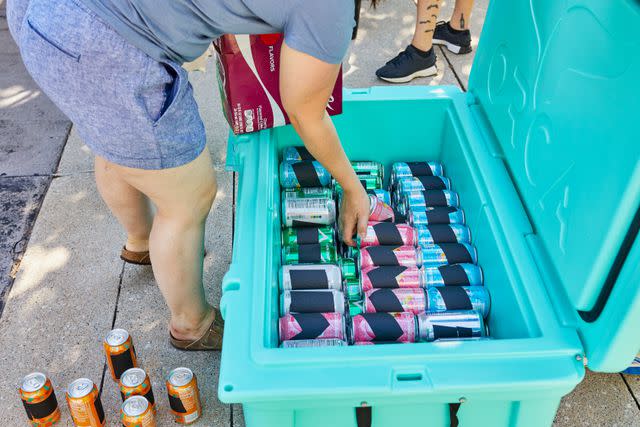
Real Simple / Henry Wortock
Best Cooler for Camping: Lifetime 65-Quart High-Performance Cooler

What Stands Out
It keeps high volumes cold for long weekends or camping trips.
What Could Be Improved
It is large and lifting it with the rope handles can feel awkward, so it may not be a great portable option.
The Lifetime 65-Quart High-Performance Cooler has great ice retention and durability without the steep price that comes with more premium models. In our testing, we found that after 24 hours, the interior temperature only dropped 0.8 degrees Fahrenheit. Plus, the can temperature measured 34.3 degrees Fahrenheit and 3/4 of the ice remained unmelted, making this cooler well suited for overnight trips. We were also wowed by the cooler’s high capacity and found that it could hold 101 cans without ice and 34 cans when filled 2/3 of the way with ice. Since it’s able to store large amounts, we recommend this cooler for long weekend getaways and summer camping trips.
We were particularly impressed with this cooler’s durability considering its price: We were able to sit on it comfortably without any buckling, and when pushed off a table (while filled to the brim with ice), the cooler didn’t open or withstand any damage.
The Lifetime cooler comes equipped with two simple fasteners, rope handles, padlock holes (the lock is sold separately), two bottle openers, and a drain plug. We did find the cooler to be a bit awkward to lift using the rope handles, and it’s one of the heavier coolers on our list, so you’ll definitely need two people to lift it onto a truck bed or table. Anyone in the market for a portable cooler will want to look elsewhere—but otherwise, this cooler is a true workhorse that rivals much more expensive models in terms of durability and ice retention.
Price at time of publish: $215
Dimensions: 18.1 x 28.4 x 17.5 inches | Capacity: 65 quarts | Weight: 25.5 pounds
Final Verdict
Our top pick, the RTIC 52-Quart Ultra-Light Cooler, stood out during our testing for its excellent insulation and leak-free design. But what’s even more impressive is that it rivals some of the most expensive models on the market.
For a more budget-friendly option, the Coleman Chiller 48-Quart Cooler is a nice entry-level cooler that can be used for most activities, including day trips, tailgating, and backyard barbecues.
Our Testing Process
We spent three days putting 48 different coolers through a series of tests, most of which were done outdoors with temperatures ranging from 80 to 95 degrees Fahrenheit (depending on the time of day) and humidity levels between 37 and 52 percent.
Our testers first evaluated the design of each cooler by opening and closing it. They took note of the ease of use and functionality of the latches, zippers, magnets, and other closure systems.
Next, testers measured the capacity of the cooler by filling it with 12-ounce cans, first without ice and again with ice. We used a 2:1 ratio of ice to cans, so the cooler was 2/3 filled with ice and 1/3 filled with cans. Testers recorded how many cans the cooler can fit with and without ice, measured the temperature inside the cooler, and recorded how many pounds of ice were used.
To evaluate the insulation, our testers opened each cooler after two hours and recorded the interior and surface temperature. (We found that the Yeti Tundra 65 Hard Cooler had the least temperature change, only increasing by 0.2 degrees Fahrenheit over 24 hours.) Using a slotted spoon, testers scooped out the remaining ice and placed it in a bucket on a scale to measure how much remained. We repeated this process after 24 hours.
Then, our testers drained the water out of the cooler using the plug or other draining mechanism, when applicable. During this test, we looked for evidence of leaking by tipping the cooler on its hinge side and its opening side, leaving it on each for one minute. We also assessed any special features and accessories, such as built-in bottle openers, cup holders, or integrated Bluetooth speakers. Additionally, testers appraised the portability of each cooler by picking it up and placing it on a table to determine how easy it is to lift while full. We also performed the following tests based on the type of cooler:
For wheeled coolers: To assess the maneuverability of these coolers, testers pulled each wheeled cooler 20 feet, made a 180-degree turn, and pushed the cooler forward 20 feet. This test was completed on both grass and concrete surfaces.
For coolers with straps: Testers walked 20 feet while carrying the cooler on their back, taking note of any padding and the ability to make adjustments.
For large coolers: Testers sat on large coolers for five minutes to see if they were sturdy and comfortable enough to use as a seat.
Finally, we tested each cooler's durability by filling it with ice and pushing it off a table and onto a concrete surface. We took note of whether it opened, cracked, or sustained any damage upon impact. Once our testers completed the above steps, they checked the retail price of each cooler and scored its overall value.
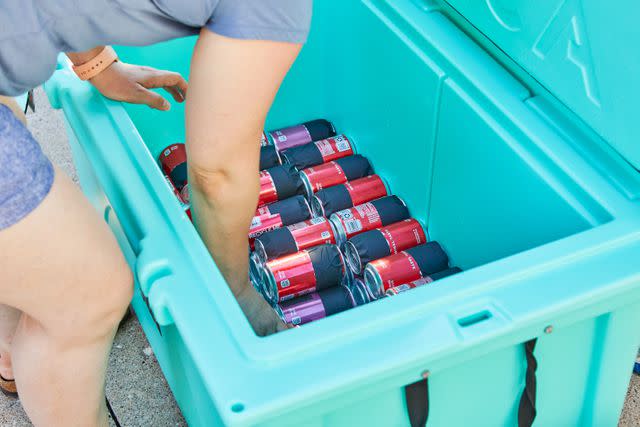
Real Simple / Henry Wortock
How to Shop for Coolers Like a Pro
Capacity
Before you start shopping, consider how you plan to use your cooler. “Count the number of people who need to utilize the cooler and evaluate how long you will be gone without access to ice,” says Jesse Schulte, a merchant for Bass Pro Shops & Cabela’s.
The coolers on our list range in capacity from 20 to 140 quarts—the former is ideal for day trips, while the latter is best reserved for professional or semi-professional outdoorsmen (such as hunters transporting game meat). It's best to pack your cooler tightly because too much air allows the temperature to rise more quickly. That's why it's important to look for a cooler that's large enough for you and your family, but not so big that you won't be able to fill it up all the way.
Some companies measure the capacity of their cooler by the number of 12-ounce cans it can hold. According to Bass Pro Shops, 1 quart equates to roughly 0.75 cans—but keep in mind that this calculation doesn't leave room for ice or cold packs, so you'll have to factor that in as well. Some people may choose to pack in more cans, while others may choose to use more ice for extended cooling (we used a 2:1 ice-to-can ratio in our testing). Refer to the chart below for general guidelines on the different cooler sizes out there:
Capacity | Number of 12-Ounce Cans (Without Ice) | Best For | |
Small | 10–35 quarts | Roughly 8 to 26 cans | - Day trips to the beach, park, campsite, etc. |
Medium | 35–55 quarts | Roughly 26 to 41 cans | - Overnight or weekend trips |
Large | 55–75 quarts | Roughly 41 to 56 cans | - Extended camping or road trips - Large families - Tailgating or other outdoor gatherings |
Extra-Large | 75+ quarts | Roughly 56 cans or more | - Hunting or fishing - Extended trips for groups of four to five - Large outdoor gatherings |
Portability
You should also consider how you'll carry your cooler. If it's just going from the house to the backyard for a barbecue, traditional grab handles will be fine (though you may have to enlist another person for the task, depending on the size of the cooler).
But if you plan to take your cooler on the go, say on a camping trip, boat ride, or beach day, you may want to consider a cooler with more efficient carrying mechanisms. You can find larger coolers with wheels for added portability, as well as smaller coolers with backpack straps that allow them to go wherever you go. Be sure to consider size, too: An extra-large cooler may take up too much space in the car, and some may not fit in the car at all.
Hard-Sided vs. Soft-Sided
Both hard-sided and soft-sided coolers come with advantages and drawbacks. Hard-sided coolers have longer ice retention (more on this below) and are more durable. They're also heavier and usually come with a higher price tag. Soft-sided coolers, on the other hand, are lightweight and easy to carry, especially since they often come with straps. However, they don't have the same ice retention as hard coolers and are therefore better suited for day trips or picnics.
Ice Retention
This simply refers to how long a cooler can keep ice frozen. Manufacturers make bold claims, from 24 hours to as long as two weeks. But these claims usually come with stipulations, such as pre-chilling the cooler, using extra ice, not opening the cooler, etc.
Ice retention can also be affected by external factors such as the air temperature and the amount of sunlight, and there's no way to know what conditions the manufacturers tested their products in. So take these claims with a grain of salt—the ice in your cooler is bound to melt faster during real-world use. If you need extra-long ice retention for extended use, look for rotomolded coolers. Made using a specific manufacturing process, these coolers are more durable and keep ice frozen for much longer.
Price
You can easily shell out several hundred dollars for a top-of-the-line cooler, which may or may not be justified depending on your needs. The coolers in our testing range in price from $40 to $600 with a median of $243. Hard-sided, rotomolded coolers, such as those from Yeti and ORCA, tend to come with the highest price tags and the longest ice retention. They also tend to be more durable and come with longer warranties.
That being said, if you don’t need a cooler for multi-day use, paying that much for a premium cooler may not make sense. Our best overall pick, the RTIC 52-Quart Ultra-Light Cooler, came in under that median price—proving you don’t necessarily need to spend top dollar for a quality cooler.
More Coolers to Consider
Xspec 60-Quart Rotomolded Cooler: In our testing, this cooler had excellent insulation, maintaining the same internal temperature for 24 hours. Its large drain also made for an easy draining process. However, it is on the heavier side and doesn’t have wheels, so it can be challenging to transport alone.
Pelican 20-Quart Elite Cooler: This cooler is sturdy and easy to carry, featuring an indent that allows it to easily rest against your hip while holding it. It also fit more cans than anticipated based on the manufacturer’s description. Even so, we found that its oddly shaped interior made it difficult to stack square and rectangular items.
Questions You Might Ask
How do coolers stay cold?
"Insulation partnered with ice are the keys to keeping your food and drinks cold," says Schulte. The ice keeps the inside of your cooler nice and chilly, while the insulated walls slow down convection—the process by which hot air travels around a space and causes the temperature to increase. Insulation also slows down the process of thermal conduction, which is when heat travels from one object to another. But keep in mind that each time the cooler is opened, warm air can find its way inside.
How should you pack a cooler to keep it cold for longer?
For best results, start by pre-chilling the food and drinks you plan to store in your cooler. Be sure to pack your cooler as full as possible, because too much air can cause the interior temperature to rise. (Tip: You can use frozen water bottles to fill up empty spaces in your cooler.) Add ice last—cool air travels down, so putting the ice on top will keep the entire cooler cold.
Schultes suggests layering using ice blocks rather than ice cubes, as blocks will melt slower. During use, be sure to store the cooler out of the sun and keep the lid closed as much as possible when not actively removing or loading items.
Take Our Word for It
This article was written by Melanie Fincher, associate commerce editor for Real Simple with three years of experience writing product reviews and lifestyle content, and updated by Jamie Fischer, commerce writer for Real Simple. To compile this list, we tested 48 coolers in our Lab and evaluated them based on design, capacity, insulation, portability, durability, and overall value. For expert tips on what to look for in a cooler, we tapped Bass Pro Shops and Cabela’s merchant Jesse Schulte.
What Is Real Simple Selects?
Next to each product on this list, you may have noticed a Real Simple Selects seal of approval. Any product appearing alongside that seal has been vetted by our team—put through tests and graded on its performance to earn a spot on our list. Although we buy most of the products we test, sometimes we do get samples from companies if purchasing a product ourselves isn’t an option. All products go through the same rigorous process, whether they are purchased or sent by the company.
Love our recommendations? Check out more products that have earned the Real Simple Selects, from humidifiers to cordless vacuums.
For more Real Simple news, make sure to sign up for our newsletter!
Read the original article on Real Simple.

